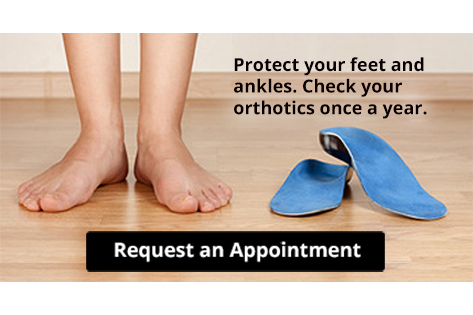Blog
What Is an Achilles Tendon Rupture?
 An Achilles tendon rupture refers to a tear of the Achilles tendon, a band of fibrous tissue that connects the calf muscles to the heel bone on the back of the lower leg. Ruptures tend to occur while playing recreational sports. They can happen to anyone, but are most common in men ages 30-50. If you have ruptured your Achilles tendon, you may hear a popping sound, which is then followed by a sudden and severe pain. An Achilles tendon rupture can make it difficult to run, stand on the toes, or climb stairs. If you think that you may have ruptured your Achilles tendon, it is suggested that you consult a podiatrist for treatment.
An Achilles tendon rupture refers to a tear of the Achilles tendon, a band of fibrous tissue that connects the calf muscles to the heel bone on the back of the lower leg. Ruptures tend to occur while playing recreational sports. They can happen to anyone, but are most common in men ages 30-50. If you have ruptured your Achilles tendon, you may hear a popping sound, which is then followed by a sudden and severe pain. An Achilles tendon rupture can make it difficult to run, stand on the toes, or climb stairs. If you think that you may have ruptured your Achilles tendon, it is suggested that you consult a podiatrist for treatment.
Achilles tendon injuries need immediate attention to avoid future complications. If you have any concerns, contact Shaun J. Limon, DPM and Lisa Griffith-Limon, DPM of Limons Foot & Ankle Care. Our doctors can provide the care you need to keep you pain-free and on your feet.
What Is the Achilles Tendon?
The Achilles tendon is a tendon that connects the lower leg muscles and calf to the heel of the foot. It is the strongest tendon in the human body and is essential for making movement possible. Because this tendon is such an integral part of the body, any injuries to it can create immense difficulties and should immediately be presented to a doctor.
What Are the Symptoms of an Achilles Tendon Injury?
There are various types of injuries that can affect the Achilles tendon. The two most common injuries are Achilles tendinitis and ruptures of the tendon.
Achilles Tendinitis Symptoms
- Inflammation
- Dull to severe pain
- Increased blood flow to the tendon
- Thickening of the tendon
Rupture Symptoms
- Extreme pain and swelling in the foot
- Total immobility
Treatment and Prevention
Achilles tendon injuries are diagnosed by a thorough physical evaluation, which can include an MRI. Treatment involves rest, physical therapy, and in some cases, surgery. However, various preventative measures can be taken to avoid these injuries, such as:
- Thorough stretching of the tendon before and after exercise
- Strengthening exercises like calf raises, squats, leg curls, leg extensions, leg raises, lunges, and leg presses
If you have any questions please feel free to contact our office located in Lakewood Ranch, FL . We offer the newest diagnostic tools and technology to treat your foot and ankle needs.
It's Time for Beautiful Feet
Daily Foot Care for Diabetics
 Diabetes can leave the feet extra vulnerable to injury and infection. Because of this, it is important to take daily steps to keep your feet healthy. Check your feet every day for cuts, blisters, red spots, and swelling. Left untreated, damage to the skin of the feet can lead to the formation of diabetic foot ulcers, slow-healing wounds that can lead to complications like infection. Keep your feet clean and well-moisturized by washing them in room temperature water, drying them thoroughly, and then applying a cream or lotion. Trim your toenails straight across regularly to avoid ingrown toenails. For more information about caring for diabetic feet, please consult with a podiatrist.
Diabetes can leave the feet extra vulnerable to injury and infection. Because of this, it is important to take daily steps to keep your feet healthy. Check your feet every day for cuts, blisters, red spots, and swelling. Left untreated, damage to the skin of the feet can lead to the formation of diabetic foot ulcers, slow-healing wounds that can lead to complications like infection. Keep your feet clean and well-moisturized by washing them in room temperature water, drying them thoroughly, and then applying a cream or lotion. Trim your toenails straight across regularly to avoid ingrown toenails. For more information about caring for diabetic feet, please consult with a podiatrist.
Diabetic foot care is important in preventing foot ailments such as ulcers. If you are suffering from diabetes or have any other concerns about your feet, contact Shaun J. Limon, DPM and Lisa Griffith-Limon, DPM from Limons Foot & Ankle Care. Our doctors can provide the care you need to keep you pain-free and on your feet.
Diabetic Foot Care
Diabetes affects millions of people every year. The condition can damage blood vessels in many parts of the body, especially the feet. Because of this, taking care of your feet is essential if you have diabetes, and having a podiatrist help monitor your foot health is highly recommended.
The Importance of Caring for Your Feet
- Routinely inspect your feet for bruises or sores.
- Wear socks that fit your feet comfortably.
- Wear comfortable shoes that provide adequate support.
Patients with diabetes should have their doctor monitor their blood levels, as blood sugar levels play such a huge role in diabetic care. Monitoring these levels on a regular basis is highly advised.
It is always best to inform your healthcare professional of any concerns you may have regarding your feet, especially for diabetic patients. Early treatment and routine foot examinations are keys to maintaining proper health, especially because severe complications can arise if proper treatment is not applied.
If you have any questions please feel free to contact our office located in Lakewood Ranch, FL . We offer the newest diagnostic and treatment technologies for all your foot and ankle needs.
Foot Conditions That May Benefit From Orthotics
 Living with daily foot pain can disrupt the quality of your life. It may cause difficulty completing daily activities. Simple things like walking and standing may become overwhelming. Many patients who are afflicted with foot pain are prescribed orthotics. Orthotics are custom made inserts that fit inside of the shoe. They are known to relieve pressure by redistributing the body’s weight, and may help in making everyday tasks more manageable. Some of the ailments orthotics can be used for include bunions, rheumatoid arthritis, and heel or arch pain, which may be caused by plantar fasciitis. If you have any type of foot pain, it is strongly recommended that you consult with a podiatrist who can determine if orthotics are right for you.
Living with daily foot pain can disrupt the quality of your life. It may cause difficulty completing daily activities. Simple things like walking and standing may become overwhelming. Many patients who are afflicted with foot pain are prescribed orthotics. Orthotics are custom made inserts that fit inside of the shoe. They are known to relieve pressure by redistributing the body’s weight, and may help in making everyday tasks more manageable. Some of the ailments orthotics can be used for include bunions, rheumatoid arthritis, and heel or arch pain, which may be caused by plantar fasciitis. If you have any type of foot pain, it is strongly recommended that you consult with a podiatrist who can determine if orthotics are right for you.
If you are having discomfort in your feet and would like to try orthotics, contact Shaun J. Limon, DPM and Lisa Griffith-Limon, DPM from Limons Foot & Ankle Care. Our doctors can provide the care you need to keep you pain-free and on your feet.
What Are Orthotics?
Orthotics are inserts you can place into your shoes to help with a variety of foot problems such as flat feet or foot pain. Orthotics provide relief and comfort for minor foot and heel pain but can’t correct serious biomechanical problems in your feet.
Over-the-Counter Inserts
Orthotics come in a wide variety of over-the-counter inserts that are used to treat foot pain, heel pain, and minor problems. For example, arch supports can be inserted into your shoes to help correct overarched or flat feet, while gel insoles are often used because they provide comfort and relief from foot and heel pain by alleviating pressure.
Prescription Orthotics
If over-the-counter inserts don’t work for you or if you have a more severe foot concern, it is possible to have your podiatrist prescribe custom orthotics. These high-quality inserts are designed to treat problems such as abnormal motion, plantar fasciitis, and severe forms of heel pain. They can even be used to help patients suffering from diabetes by treating foot ulcers and painful calluses and are usually molded to your feet individually, which allows them to provide full support and comfort.
If you are experiencing minor to severe foot or heel pain, it’s recommended to speak with your podiatrist about the possibilities of using orthotics. A podiatrist can determine which type of orthotic is right for you and allow you to take the first steps towards being pain-free.
If you have any questions please contact our offices located in Bradenton and Lakewood Ranch, FL . We offer the newest diagnostic and treatment technologies for all your foot and ankle needs.
Read more about Foot OrthoticsHeel Pain Can Be Treated!
Symptoms of Gout
 Severely inflamed joints in the big toe is a common symptom of the medical condition that is known as gout. Gout can develop as a result of excess uric acid in the blood, and this can occur for different reasons. These can include eating foods that have elevated levels of purines, including red meat and shellfish. Additionally, genetic factors may play a significant role in experiencing gout attacks. This ailment typically targets the joints in the big toe, and common symptoms can include extreme pain and tenderness, which may become debilitating. Research has indicated that there are methods that may help prevent the onset of gout. These can consist of losing weight, drinking plenty of fresh water daily, and incorporating fruits and vegetables as part of a healthy eating plan. If you are afflicted with gout, it is urgent that you are under the care of a podiatrist who can properly treat this condition.
Severely inflamed joints in the big toe is a common symptom of the medical condition that is known as gout. Gout can develop as a result of excess uric acid in the blood, and this can occur for different reasons. These can include eating foods that have elevated levels of purines, including red meat and shellfish. Additionally, genetic factors may play a significant role in experiencing gout attacks. This ailment typically targets the joints in the big toe, and common symptoms can include extreme pain and tenderness, which may become debilitating. Research has indicated that there are methods that may help prevent the onset of gout. These can consist of losing weight, drinking plenty of fresh water daily, and incorporating fruits and vegetables as part of a healthy eating plan. If you are afflicted with gout, it is urgent that you are under the care of a podiatrist who can properly treat this condition.
Gout is a foot condition that requires certain treatment and care. If you are seeking treatment, contact Shaun J. Limon, DPM and Lisa Griffith-Limon, DPM from Limons Foot & Ankle Care. Our doctors will treat your foot and ankle needs.
What Is Gout?
Gout is a type of arthritis caused by a buildup of uric acid in the bloodstream. It often develops in the foot, especially the big toe area, although it can manifest in other parts of the body as well. Gout can make walking and standing very painful and is especially common in diabetics and the obese.
People typically get gout because of a poor diet. Genetic predisposition is also a factor. The children of parents who have had gout frequently have a chance of developing it themselves.
Gout can easily be identified by redness and inflammation of the big toe and the surrounding areas of the foot. Other symptoms include extreme fatigue, joint pain, and running high fevers. Sometimes corticosteroid drugs can be prescribed to treat gout, but the best way to combat this disease is to get more exercise and eat a better diet.
If you have any questions please feel free to contact our offices located in Bradenton and Lakewood Ranch, FL . We offer the newest diagnostic and treatment technologies for all your foot and ankle needs.
Read more about GoutReminder: When Was the Last Time...?
Runners May Be Prone to Stress Fractures
 Patients who enjoy running marathons are familiar with the possibility of getting stress fractures. They can happen as a result of increasing mileage and speed too soon and not warming up properly before running. A stress fracture is defined as a hairline fracture in the bones that can gradually develop over time. The symptoms that patients experience include pain, swelling, and difficulty walking. Additional reasons why this type of injury can occur include wearing shoes that do not fit correctly or frequently changing running surfaces. After a proper diagnosis is performed, which generally consists of having an X-ray taken, treatment can begin. Treatment options can include wearing a protective boot for approximately six weeks. If you have endured a stress fracture, please speak with a podiatrist as soon as possible.
Patients who enjoy running marathons are familiar with the possibility of getting stress fractures. They can happen as a result of increasing mileage and speed too soon and not warming up properly before running. A stress fracture is defined as a hairline fracture in the bones that can gradually develop over time. The symptoms that patients experience include pain, swelling, and difficulty walking. Additional reasons why this type of injury can occur include wearing shoes that do not fit correctly or frequently changing running surfaces. After a proper diagnosis is performed, which generally consists of having an X-ray taken, treatment can begin. Treatment options can include wearing a protective boot for approximately six weeks. If you have endured a stress fracture, please speak with a podiatrist as soon as possible.
Activities where too much pressure is put on the feet can cause stress fractures. To learn more, contact Shaun J. Limon, DPM and Lisa Griffith-Limon, DPM from Limons Foot & Ankle Care. Our doctors can provide the care you need to keep your pain free and on your feet.
Dealing with Stress Fractures of the Foot and Ankle
Stress fractures occur in the foot and ankle when muscles in these areas weaken from too much or too little use. The feet and ankles then lose support when walking or running from the impact of the ground. Since there is no protection, the bones receive the full impact of each step. Stress on the feet can cause cracks to form in the bones, thus creating stress fractures.
What Are Stress Fractures?
Stress fractures occur frequently in individuals whose daily activities cause great impact on the feet and ankles. Stress factors are most common among:
- Runners
- People affected with Osteoporosis
- Tennis or basketball players
- Gymnasts
- High impact workouts
Symptoms
Pain from the fractures occur in the area of the fractures and can be constant or intermittent. It will often cause sharp or dull pain with swelling and tenderness. Engaging in any kind of activity which involves high impact will aggravate pain.
If you have any questions please feel free to contact our offices located in Bradenton and Lakewood Ranch, FL . We offer the newest diagnostic and treatment technologies for all your foot and ankle needs.
Read more about Dealing with Stress Fractures of the Foot and AnkleRisk Factors for Cuboid Syndrome
Cuboid syndrome occurs when the cuboid bone in the foot moves down and out of alignment with the calcaneus bone. This can happen due to sudden injury or from repetitive overuse from activities and sports that involve a lot of jumping, changing directions, or sprinting. Symptoms of cuboid syndrome include foot pain, swelling, tenderness, weakness, and a decreased range of motion. Certain risk factors can make cuboid syndrome more likely. These include being overweight or obese, having pronated feet, wearing poorly-fitted shoes, training on uneven surfaces, and having a previous or concurrent ankle or foot sprain. If you are experiencing the symptoms of cuboid syndrome, it is suggested that you see a podiatrist for diagnosis and treatment.
Cuboid syndrome, also known as cuboid subluxation, occurs when the joints and ligaments near the cuboid bone in the foot become torn. If you have cuboid syndrome, consult with Shaun J. Limon, DPM and Lisa Griffith-Limon, DPM from Limons Foot & Ankle Care. Our doctors will assess your condition and provide you with quality foot and ankle treatment.
Cuboid syndrome is a common cause of lateral foot pain, which is pain on the outside of the foot. The condition may happen suddenly due to an ankle sprain, or it may develop slowly overtime from repetitive tension through the bone and surrounding structures.
Causes
The most common causes of cuboid syndrome include:
- Injury – The most common cause of this ailment is an ankle sprain.
- Repetitive Strain – Tension placed through the peroneus longus muscle from repetitive activities such as jumping and running may cause excessive traction on the bone causing it to sublux.
- Altered Foot Biomechanics – Most people suffering from cuboid subluxation have flat feet.
Symptoms
A common symptom of cuboid syndrome is pain along the outside of the foot which can be felt in the ankle and toes. This pain may create walking difficulties and may cause those with the condition to walk with a limp.
Diagnosis
Diagnosis of cuboid syndrome is often difficult, and it is often misdiagnosed. X-rays, MRIs and CT scans often fail to properly show the cuboid subluxation. Although there isn’t a specific test used to diagnose cuboid syndrome, your podiatrist will usually check if pain is felt while pressing firmly on the cuboid bone of your foot.
Treatment
Just as the range of causes varies widely, so do treatments. Some more common treatments are ice therapy, rest, exercise, taping, and orthotics.
If you have any questions, please feel free to contact our office located in Lakewood Ranch, FL . We offer the newest diagnostic and treatment technologies for all your foot care needs.
Why Live with Pain and Numbness in Your Feet?
More...
Athlete's Foot Symptoms
Athlete’s foot refers to a fungal infection of the skin on the feet. While the infection is common among athletes, you don’t have to be one to get it. Athlete’s foot is contagious and spreads through direct contact between the fungus and your skin. You can pick up this infection from walking barefoot in public spaces, particularly in warm, moist environments such as locker rooms and swimming pools, or from sharing personal items such as towels and socks. Athlete’s foot has several noticeable symptoms, including an itching, stinging, or burning sensation between the toes or on the soles, and dry, cracking, peeling, or raw skin on the feet. Often this infection can spread to the toenails, causing them to become discolored, thick, and crumbly. If you have symptoms of athlete’s foot, it is suggested that you see a podiatrist for treatment.
Athlete’s foot is an inconvenient condition that can be easily reduced with the proper treatment. If you have any concerns about your feet and ankles, contact Shaun J. Limon, DPM and Lisa Griffith-Limon, DPM from Limons Foot & Ankle Care. Our doctors will treat your foot and ankle needs.
Athlete’s Foot: The Sole Story
Athlete's foot, also known as tinea pedis, can be an extremely contagious foot infection. It is commonly contracted in public changing areas and bathrooms, dormitory style living quarters, around locker rooms and public swimming pools, or anywhere your feet often come into contact with other people.
Solutions to Combat Athlete’s Foot
- Hydrate your feet by using lotion
- Exfoliate
- Buff off nails
- Use of anti-fungal products
- Examine your feet and visit your doctor if any suspicious blisters or cuts develop
Athlete’s foot can cause many irritating symptoms such as dry and flaking skin, itching, and redness. Some more severe symptoms can include bleeding and cracked skin, intense itching and burning, and even pain when walking. In the worst cases, Athlete’s foot can cause blistering as well. Speak to your podiatrist for a better understanding of the different causes of Athlete’s foot, as well as help in determining which treatment options are best for you.
If you have any questions please feel free to contact our office located in Lakewood Ranch, FL . We offer the newest diagnostic and treatment technologies for all your foot and ankle needs.
What Does Sever's Disease Look Like?
 Sever’s disease is an overuse injury common in younger children and adolescents who participate in running or jumping activities. This condition is caused by repetitive injury to the growth plate in the heel. If your child has Sever’s disease, they will often exhibit heel pain that begins gradually and worsens with exercise, affects both feet, and improves with rest. They may also exhibit tenderness in their heel when it is touched, pain when the ankle is raised upward, and mild swelling in the heel. In cases that have lasted for a longer period of time, your child may also have an enlarged heel bone. If your child complains of heel pain, it is recommended that you seek the care of a podiatrist who can diagnose and treat Sever’s disease and other foot and ankle conditions.
Sever’s disease is an overuse injury common in younger children and adolescents who participate in running or jumping activities. This condition is caused by repetitive injury to the growth plate in the heel. If your child has Sever’s disease, they will often exhibit heel pain that begins gradually and worsens with exercise, affects both feet, and improves with rest. They may also exhibit tenderness in their heel when it is touched, pain when the ankle is raised upward, and mild swelling in the heel. In cases that have lasted for a longer period of time, your child may also have an enlarged heel bone. If your child complains of heel pain, it is recommended that you seek the care of a podiatrist who can diagnose and treat Sever’s disease and other foot and ankle conditions.
Sever's disease often occurs in children and teens. If your child is experiencing foot or ankle pain, see Shaun J. Limon, DPM and Lisa Griffith-Limon, DPM from Limons Foot & Ankle Care. Our doctors can treat your child’s foot and ankle needs.
Sever’s Disease
Sever’s disease is also known as calcaneal apophysitis, which is a medical condition that causes heel pain I none or both feet. The disease is known to affect children between the ages of 8 and 14.
Sever’s disease occurs when part of the child’s heel known as the growth plate (calcaneal epiphysis) is attached to the Achilles tendon. This area can suffer injury when the muscles and tendons of the growing foot do not keep pace with bone growth. Therefore, the constant pain which one experiences at the back of the heel will make the child unable to put any weight on the heel. The child is then forced to walk on their toes.
Symptoms
Acute pain – Pain associated with Sever’s disease is usually felt in the heel when the child engages in physical activity such as walking, jumping and or running.
Highly active – Children who are very active are among the most susceptible in experiencing Sever’s disease, because of the stress and tension placed on their feet.
If you have any questions, please feel free to contact our office located in Lakewood Ranch, FL . We offer the newest diagnostic and treatment technologies for all your foot and ankle injuries.
Plantar Warts Can Be Treated!
Can Obesity Cause Flat Feet?
 Obesity has become increasingly common worldwide in recent years. This condition has implications for the health of the whole body, including foot health. Prevalence of flat feet, a condition characterized by a lack of an arch at the midfoot, appears to be higher in obese people. While many cases of flat feet are caused by genetics, flat feet can also be an acquired condition that occurs when the arch of the foot weakens and collapses over time. Being overweight or obese can increase the risk of the arch flattening, as the feet bear the weight of the entire body. This can be a problem, as flat feet can cause foot pain in the heel and arch areas. For more information about the connection between your weight and your foot health, please consult with a podiatrist.
Obesity has become increasingly common worldwide in recent years. This condition has implications for the health of the whole body, including foot health. Prevalence of flat feet, a condition characterized by a lack of an arch at the midfoot, appears to be higher in obese people. While many cases of flat feet are caused by genetics, flat feet can also be an acquired condition that occurs when the arch of the foot weakens and collapses over time. Being overweight or obese can increase the risk of the arch flattening, as the feet bear the weight of the entire body. This can be a problem, as flat feet can cause foot pain in the heel and arch areas. For more information about the connection between your weight and your foot health, please consult with a podiatrist.
The more you weigh, the harder your feet must work to support your body. If you’re an obese individual and are concerned about your feet, contact Shaun J. Limon, DPM and Lisa Griffith-Limon, DPM from Limons Foot & Ankle Care. Our doctors can provide the care you need to keep you pain-free and on your feet.
Obesity and Your Feet
People who are overweight are putting more pressure on their ankles, knees, and hips as well as their feet. This unfortunately can lead to variety of different issues.
Problems & Complications Stemming from Obesity
- When the body is overweight, it tries to compensate by changing the way that it moves. An obese person may lean forward and put extra weight on the wrong part of the foot. This puts unnecessary stress on the feet.
- Obese people are also more likely to develop type II diabetes which is a condition that causes a lot of foot problems. People with diabetes often don’t feel the cuts and sores that they may have on their feet, which can lead to more complicated and severe issues.
- Plantar fasciitis is another foot condition that can be caused by obesity. Plantar fasciitis is an inflammation of the tissue along the bottom of the foot, which causes pain and stiffness while walking and climbing stairs.
If you have any questions, please feel free to contact our office located in Lakewood Ranch, FL . We offer the newest diagnostic and treatment technologies for all your foot care needs.







